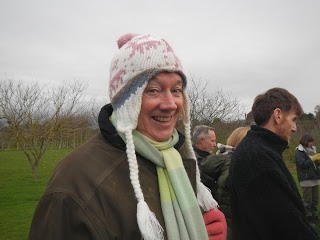The Kentish Cobnuts Association offered a pruning training morning in January. Just four of the Nutters group went along to Roughway Farm at the invitation of John Cannon and Giles Cannon to learn from experts and improve their skills.
The session started with coffee and an illustrated talk in the oast barn where John Cannon pointed out some characteristics of cobnut trees and their pruning, as well as giving us some history of cobnut growing in Kent.
We then moved outside to visit a number of different plats around the farm, in various stages of development and conditions. The first was a group of mature Kent Cobnut trees - probably over a hundred years old where the nut-bearing branches needed thinning to let light into the centre of the trees. This was an opportunity to get 'hands on', using pruning saws, loppers and secateurs, with benefit of advice from the Cannons, father and son.
.JPG) |
| Kent Cobnut trees, between 100 and 150 years old |
The second stop was a more recently-planted area, mainly of the variety Butler. Giles Cannon demonstrated the use of powered secateurs with which he made extremely fast work, using a battery back-pack, taking out the wands at the base of the tree as well as working rapidly through the nut-bearing branches, removing any dead or crossing-over branches and thinning the rest to produce more substantial nuts and to let the sunlight in to ripen the crop. We were reminded that the leaves, which can be as big as a small plate in summer, will prevent much of the light from getting to where it is needed and this is why the open goblet shape is necessary for ripening the crop.
.JPG) |
| Wands have been stripped from the base of the tree using powered secateurs. from fairly recently-planted 'Butler' variety |
The third plat visited had recently been taken on by the Cannons and contained trees which had been 'let go' for some considerable time. It was interesting because it resembled the state our own nut plat had been in when work started in 2011/12 and the approach to bringing it back into productive form was similar.
It was an interesting morning and an opportunity to meet other growers from around Kent and beyond. Well done to those brave and hardy souls who dressed up warm and braved the biting winds.
 |
| Dressed to beat the cold |

.JPG)
.JPG)
.JPG)
